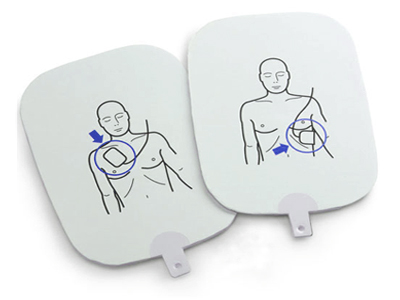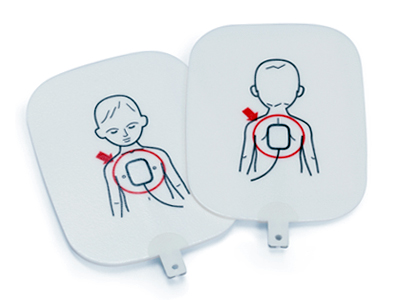Using AED
USING AED
Unlike defibrillators used in emergency rooms, an automated external defibrillator (AED) requires very little training to use. And while functionality and features vary slightly from one model to another, most AED’s microprocessors are almost fool-proof as they guide the operator through each step with audible and visual prompts. Before defibrillation is administered the victim’s chest must be dry and bare of clothing. If a female victim is wearing a bra with metal underwire, it must also be removed to avoid potential electrical interference.
 Retrieve the AED and position it near the victim as promptly as possible. If the victim is in water, carefully move the victim to a dry area. When the device is turned on it will instruct the operator to connect the electrodes (pads) to the victim. These pads allow the AED to examine the electrical output from the victim’s heart and determine if a shock is required. Follow the AED instructions and voice prompts by placing one pad above the victim’s right nipple/upper chest area, and the second pad below the left armpit, on the lower rib area, ensuring full and firm contact with the victim’s skin.
Retrieve the AED and position it near the victim as promptly as possible. If the victim is in water, carefully move the victim to a dry area. When the device is turned on it will instruct the operator to connect the electrodes (pads) to the victim. These pads allow the AED to examine the electrical output from the victim’s heart and determine if a shock is required. Follow the AED instructions and voice prompts by placing one pad above the victim’s right nipple/upper chest area, and the second pad below the left armpit, on the lower rib area, ensuring full and firm contact with the victim’s skin.
If the victim has a known or suspected pacemaker (above the right nipple you note a lump with a scar over it) do not to place the AED pad over the pacemaker. Place the right pad an inch away (3cm) from the pacemaker. If you note a medication patch on the victim’s chest, remove the patch and wipe any medication residue with a cloth being careful to not touch the medication with your bare hand.
AED ON CHILD AND INFANT VICTIMS
When using an AED on a child or infant, if pediatric pads are included with the AED, use those pads as directed, however, if the child  or infant is small, be sure the pads do not touch each other. If you are unable to attach the pads to the child or infant as directed due to touching, apply one pad to the center of the child or infant’s chest and one pad to the middle of the child or infant’s back (between the shoulder blades). If the AED only has one set of pads (adult sized), apply one pad to the middle of the child’s chest and the other to the middle of the child’s back, as previously stated. Studies have shown that use of AED in adults, children and infants have drastically improved the outcomes of out of hospital cardiac arrests in all age categories, even when only adult sized pads were available
or infant is small, be sure the pads do not touch each other. If you are unable to attach the pads to the child or infant as directed due to touching, apply one pad to the center of the child or infant’s chest and one pad to the middle of the child or infant’s back (between the shoulder blades). If the AED only has one set of pads (adult sized), apply one pad to the middle of the child’s chest and the other to the middle of the child’s back, as previously stated. Studies have shown that use of AED in adults, children and infants have drastically improved the outcomes of out of hospital cardiac arrests in all age categories, even when only adult sized pads were available
It’s critical to remember that once the pads are attached, the victim must not be touched by another person as this may cause the AED to produce inaccurate readings – in other words, stand clear of the victim. The AED will analyze the victim’s heartbeat and if it determines that a shock is needed, it will charge and announce a distinct loud warning similar to “Preparing for shock… Charging… Clear…”. Again, make sure that no one is making any kind of physical contact with the victim to avoid the possibility of accidental injury.
Some AED models will administer the shock automatically, while some (semi-automatic) will prompt  the operator to press the “shock” button. After delivering the shock most AED’s will again analyze the victim and will either administer another shock (automatically or manually), or instruct the operator to perform CPR which will help to circulate oxygenated blood to the victim’s brain until EMS arrives.
the operator to press the “shock” button. After delivering the shock most AED’s will again analyze the victim and will either administer another shock (automatically or manually), or instruct the operator to perform CPR which will help to circulate oxygenated blood to the victim’s brain until EMS arrives.